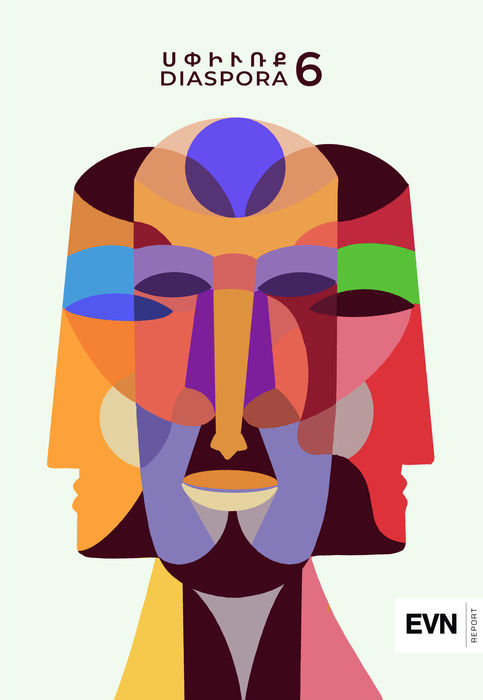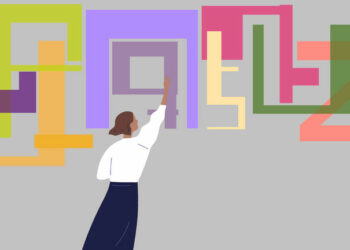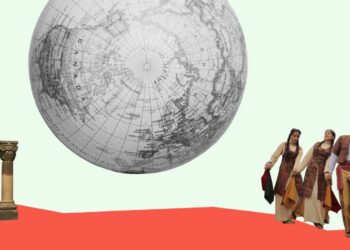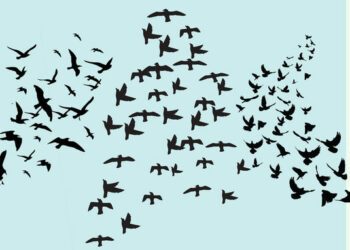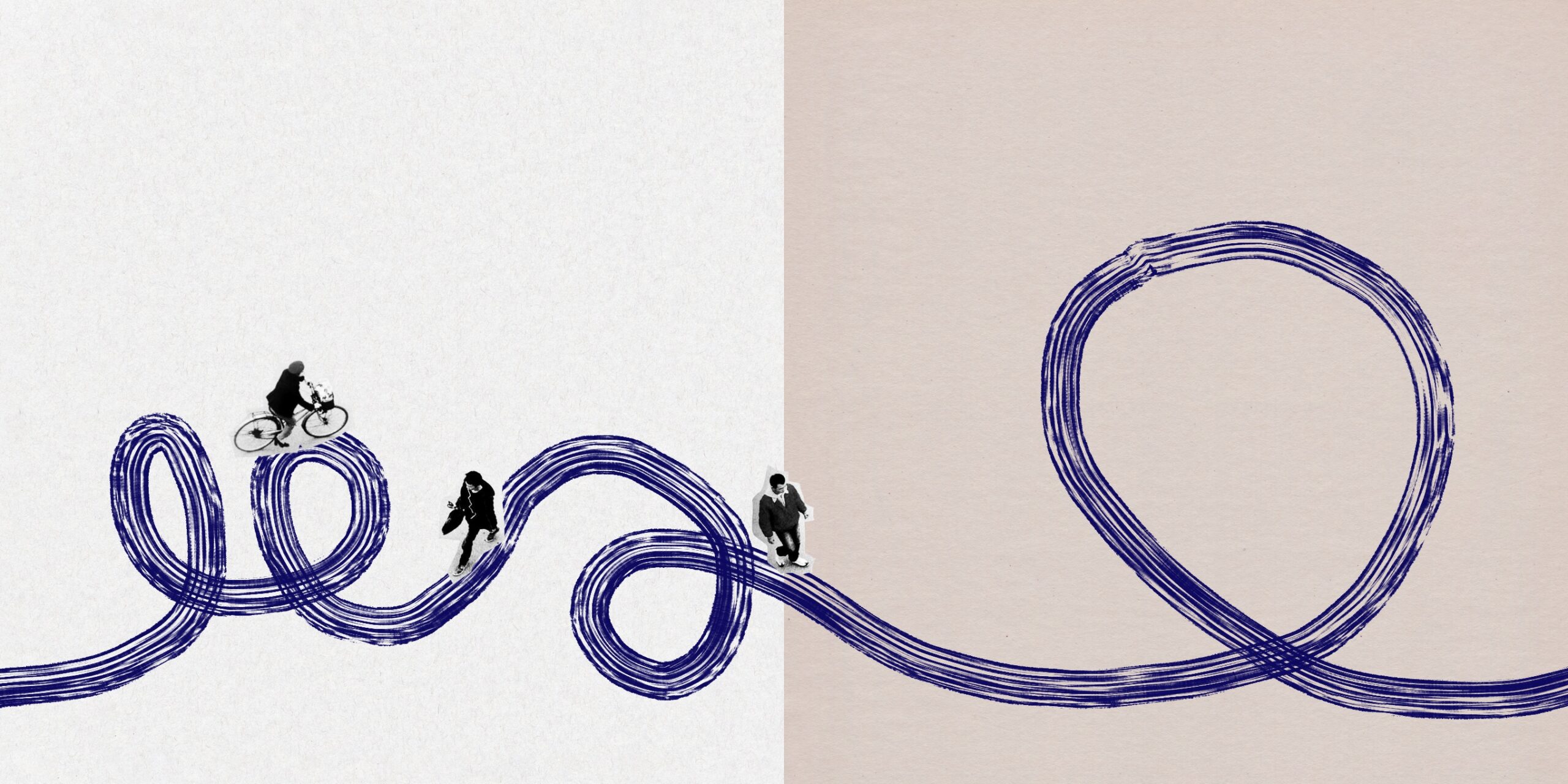
Illustration by Armine Shahbazyan.
It has become customary for His Holiness Aram I, the Catholicos of the Great House of Cilicia, to use his new year address to dedicate the coming year to a different segment of the global Armenian community. For example, 2021 was the Year of Artsakh, 2020 was the Year of Armenians With Special Needs, 2019 was the Year of the Armenian Media and Press, etc.[1]
2022 was proclaimed the Year of the Armenian Diaspora. In the announcement, Aram I describes the origins of the diaspora, dating back to the Middle Ages, its permanence across the centuries, its pluralistic identity and challenges. He paints a realistic (let’s not say pessimistic) picture of the current state of affairs in the diaspora. This is an opportunity to reflect on the great challenges faced by the Armenian world on the eve of each new year. If this is a truly candid exercise in self-reflection, certain points deserve to be explored in further detail.
Carrying with it the stigmata of the Armenian people’s martyrdom since its exile in 1920, the Antelias Catholicosate continues to hold an important place in the Armenian world. It is likely the best-placed national institution to speak in the name of the diaspora, keeping in mind its diversity. A living embodiment within its material and spiritual dimension, carrying with it a single voice and a single conscience on the struggle for truth and justice, this Catholicosate is the living testament that occupies a unique place of faith and aspiration for justice. Benefiting from a wide global network of dioceses and its visceral attachment to the Armenian language and literature, the See of Cilicia is a real hub of transnational consciousness, which has enabled it to pursue a coherent policy over the last half-century, structured around three essential prongs: (1) cultivating new spiritual and intellectual cadres to maintain “Armenianness” in the diaspora, ready to uphold the Armenian Cause in both the political and cultural spheres, (2) interfaith dialogue and (3) ecumenism between eastern and western churches. The endless succession of conferences on the future of Armenian identity or eastern Christianity organized in Antelias, Lebanon, reveals that, if the Holy See of Cilicia no longer resides on Armenian soil, it retains the gravitational pull of a de-territorialized but spiritualized Armenian Nation—a key distinction from the Holy See of Etchmiadzin, which, for its part, remains firmly anchored on Armenian land.
Turning Water into Wine
Aram I’s message is that Armenian identity in the diaspora cannot be taken for granted. It’s a choice, a commitment. As a keen observer of the real world, he remains as clear-headed as ever: our structures are not adequately adapting to new realities faced by the community. The diaspora is paralyzed, creativity and vitality are at a standstill, and idleness is palpable. Thus, how can the slogan “Strong Diaspora, Strong Armenia” regain its value? The ultimate fragmentation of “diasporaness” is well understood, but Aram I doesn’t speak of an ideal community model for the 21st century, even if he obviously takes inspiration from the traditional model that preserved “Armenianness” for several generations in the Middle East. This model imagines Armenian life centered around the Church, School and Press: a communal, if not communitarian, model inspired by the Ottoman millet-system, which is obviously not directly exportable to the West.
The other section that requires attention is the passage on how to prevent the youth from abandoning an Armenian life. The Catholicos is fully aware of a tendency among Armenian youth to assimilate, and hopes to reverse it. In countries where your ethnicity is not printed in your passport, being Armenian is effectively a choice, but to what end? It’s hard to contemplate creating new out of old; that’s the entire crux of the issue at hand. The progenial communities of the diaspora in Syria and Lebanon have suffered immensely, while the Republic of Armenia evolves like a rudderless ship adrift without a pilot and without the sense of urgency to establish a realistic “national strategy”. The Catholicos is thus faced with quite the obstacle: the representation of what’s real and the inability to reconcile the agonizing past with the nebulous future.
A very concrete example of the disconnect between the real world and destructive fantasy is that of diasporan repatriation to Armenia. Given the current situation, it is an unrealistic proposition for the Catholicos, despite the “Strong Armenia” mentality. One of his predecessors, the Artsakh-born Catholicos Karekin I Hovsepiants (1867-1952) who held the seat from 1943 until his death, had been a fervent advocate for repatriation (Nerkaght), even at the cost of diluting the demographics of his flock in the diaspora. The ideal of a strong Armenia reborn from the ashes superseded anything else. From that point on, the question remained: how can Antelias use its leverage to support this action? Must we create more dioceses to serve the transplants from Syria and Lebanon, including in France? That would add yet another fault line between the two Catholicosates. Yet, considering the state of moral crisis currently facing the Armenian Church in France, it might be worth a shot. In the age of globalization, the diaspora can no longer continue to exist as a transnational identity as a means in itself, without an agenda. To formulate this agenda, the Catholicos extends a hand to all representatives of the living Armenian nation, without exception. Such a reorganization or restructuring effort cannot succeed without a reboot.
Three Concentric Circles
To give credit where credit is due, the Catholicos’ message calls for a move away from armeno-centric thinking (that is to not solely be focused on the Armenian world, but as a Lebanon-based institution, act for all Christians in the Middle East). It’s by coming together with others that the Armenian Church and the diaspora will grow in influence. Once these mechanisms and actors are identified, the next step is to tackle the question of a common vision for the future. And for such a vision to be fostered, a change of perspective becomes a necessity.
We come to draw three easily identifiable concentric circles:
- The pan-Armenian circle, at the center of which Antelias plays the role of spiritual capital of the diaspora, and an anchor for the pursuit of the Armenian Cause, as well as Armenology, due to its vast network and structures.
- The ecunemical and interfaith circle in which Antelias has excelled for over a half-century. Let’s not forget that Catholicos Aram I has been elected head of the World Council of Churches on several occasions, an unmatched feat in the organization’s history.
- Parallel diplomacy with the sister-Oriental Orthodox Churches that share our concerns (Syriac, Coptic Orthodox) , as well as other Oriental churches as the Greek Orthodoxe, Melkite, Maronite Church) and are also endowed with strong diasporas, but reinforced by cooperation with other partners including civil society, and political entities like the Lebanese State and the Kurdish Regional Government of Iraq to achieve common goals.
At the heart of Oriental Christianity, much is expected of the Armenians. Their reputation as mediators and their appetite for getting to work are unanimously respected. The time to be content with pious wishes has passed; now is the time for a rational assessment of our situation and to propose realistic steps with the human resources available to make effective use of the diaspora’s extraordinary potential, which began filtering out of the Middle East 40 years ago. The key here is to build a bridge between the visionary centers (Antelias and Yerevan) and the periphery in distress. We must arm ourselves with an agenda for the here and now. We need to breathe new life into a youth which is not just assimilating but “disassociating” itself from an Armenian world which no longer supplies it with physical or spiritual validation.
Footnote
[1] The full list of annual proclamations is shown below:
2003: Year of the Gospel
2004: Year of the Family
2005: Year of Der Zor
2006: Year of the Armenian School
2007: Year of the Armenian Language
2008: Year of Christian Education
2009: Year of the Youth
2010: Year of the Armenian Woman
2011: Year of the Armenian Child
2012: Year of the Armenian Book
2013: Year of the Armenian Mother
2014: Year of the Elder
2015: Year of the Armenian Genocide Centennial
2016: Year of Service
2017: Year of Renewal
2018: Year of the First Republic of Armenia
2019: Year of the Armenian Media and Press
2020: Year of Armenians with Special Needs
2021: Year of Artsakh
2022: Year of the Armenian Diaspora
Magazine Issue N6
Diaspora
The Terrain of “Living” Western Armenian Literature
Western Armenian literature does live in many different environments, traditional or innovative. The question, however, is in what conditions or with what prospects? New pathways are necessary to keep it “living.”
Read moreGround Zero: Back to the Question of the Diaspora
Will the 2020 Artsakh War be a turning point for the diaspora to reassess and define a new agenda for itself? Dr. Khatchik DerGhougassian argues that a paradigm shift has started to occur in how the diaspora sees itself and its relationship with the homeland.
Read moreDiaspora Conceptualizations and the Realities of the Armenian Diaspora: Some Preliminary Observations
Do diasporas have agency, imagined and conceptualized, to produce collective behavior or are they too vast and heterogeneous to generate any coordinated collective action in unison?
Read morePost-War Reflections From the Diaspora
The diaspora must continue to invest in rebuilding and channeling diasporic potential following the 2020 Artsakh War. This is not 1915, writes Lalai Manjikian, the nation has a huge pool of educated, driven and competent forces.
Read more
